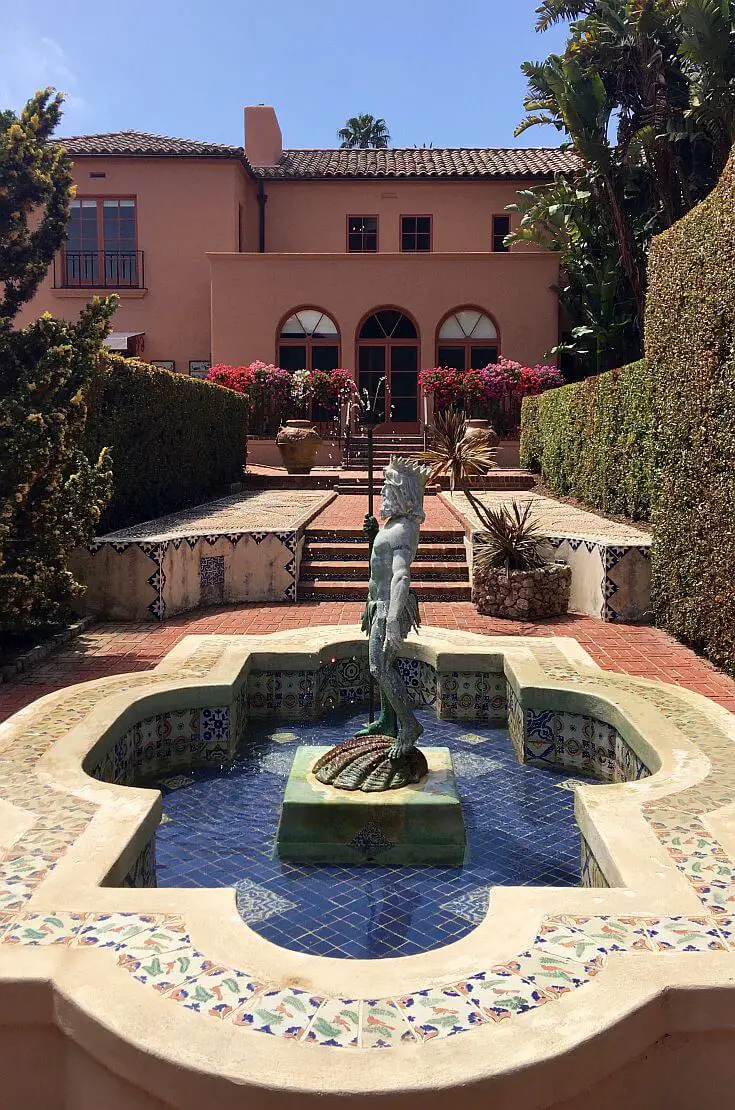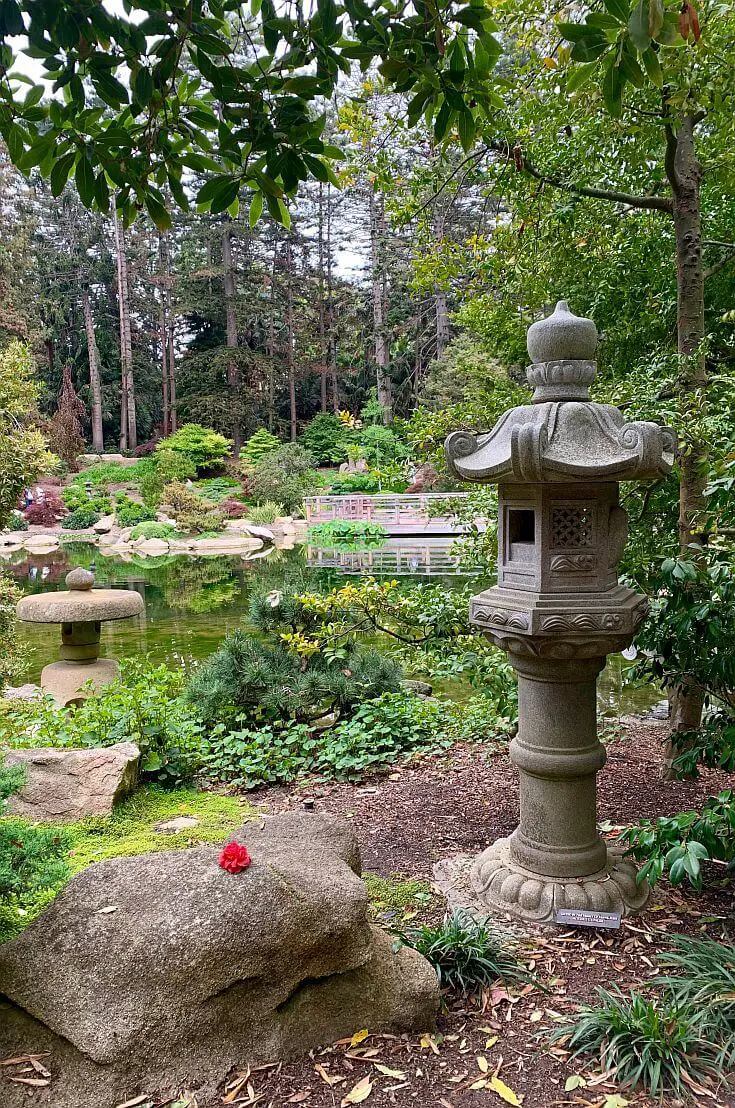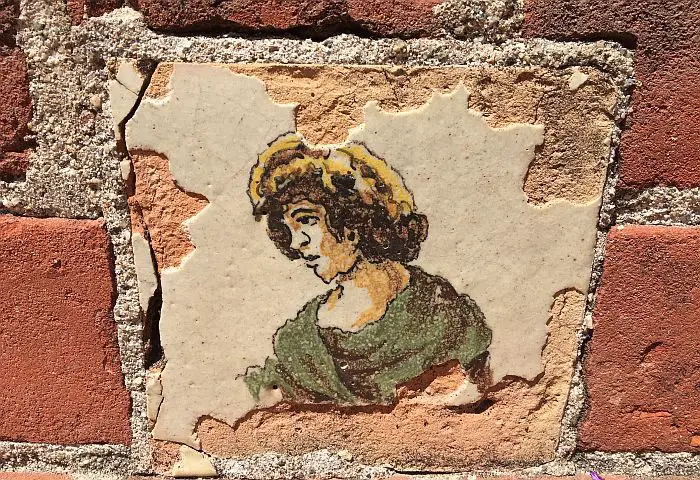A Strange Garden With a Backstory: Ganna Walska's Lotusland
Story and photos by Sherry Shahan
A European singer with questionable talent, one who forewarned the reality TV age by being famous for being famous, created a public garden as flamboyant as her lifestyle.

"I have a particular aversion to following the multitude in styles of any kind," early 20th-century opera star Ganna Walska wrote in her autobiography. She lived by the credo, "enemy of the average."
The spectacular and unusual garden she created, Lotusland, keeps her memory alive in California. It's a strange and artistic showpiece using plants to set scenes and create unexpected visual combinations.
I spend an hour or so each day in a garden that's 8 by 24 feet at my house in California. If for some reason I'm away during the day, I turn on the porch light when I get home and putter around. I once raised Yukon gold potatoes in the cardboard box that delivered a stereo system and still grow carrot tops in ice cube trays for pesto.
So what took me so long to make the two-hour drive to Ganna Walska Lotusland in Santa Barbara? To revel in an open-air museum that's erratic, beautifully eye-catching and one of the most notable horticultural collections in the world?
Gardens for Generations
 Madame Ganna Walska purchased the sprawling 37-acre estate in a residential area of Montecito, California in 1941. She spent the next four-plus decades working with landscape designers and acquiring rare and exotic plants for a labyrinth of themed gardens.
Madame Ganna Walska purchased the sprawling 37-acre estate in a residential area of Montecito, California in 1941. She spent the next four-plus decades working with landscape designers and acquiring rare and exotic plants for a labyrinth of themed gardens.
Mme. Walska snipped articles and photos of gardens from magazines, filling scrapbooks for potential projects. "It seems to me that the best way to develop creativeness is to learn the technique of the great artists and to imitate them," she wrote. "First, do as well as they do; then try to surpass them in order, finally, to surpass yourself... "
In 1882, the property belonged to pioneer horticulturist Ralph Kinton Stevens, who developed a lemon and palm nursery. Stevens introduced the Asian lotus (an exotic aquatic perennial) to Lotusland, then called Tanglewood. Subtropical dragon trees with wide spreading, umbrella-like limbs, Chilean wine palms, and olive trees remain from his experimental garden.
Palmer and Marie Gavit purchased the estate in 1919, calling it Cuesta Linda or "pretty hill." In 1919, architect Reginald Johnson designed a stately mansion for the couple. The vibe remains opulent, 1920s-style Hollywood. (Johnson also designed Santa Barbara's Biltmore Hotel, built in 1927.)
The Gavits commissioned a Parterre Rose Garden, a maze of formal rose beds in symmetrical patterns with brick pathways, tiled fountains, and ponds. When Ganna Walska took ownership, she renamed it Tibetland and later Lotusland, after the flower sacred to Indian and Tibetan religions. Madame added her own character to the parterre, contrasting the traditional and serene with intricate pebble mosaics and bold clusters of cacti and succulents.
She's known for saying, "More is better."
Ganna Walska's Fame and Infamy
Mme. Walska was born Hanna Puacz in Poland in 1887, a time when young girls weren't permitted to go to the theater, since plots invariably hinged on romance. Reading newspapers or novels, unthinkable. The circus was a tolerated form of entertainment. She only knew music and singing from church.
 Hanna eloped in her late teens with a Russian count, her first husband. She created a stage identity because married women weren't allowed to have their names appear in print—not even on a "visiting" card—so she wasn't able to use her husband's name to sing at a charity event.
Hanna eloped in her late teens with a Russian count, her first husband. She created a stage identity because married women weren't allowed to have their names appear in print—not even on a "visiting" card—so she wasn't able to use her husband's name to sing at a charity event.
In her autobiography Always Room at the Top (1943) she wrote, "The name is fictitious anyhow and was born in an emergency. At the eleventh hour I had to think up a substitute . . . " Ganna, considered more exotic than Hanna, and Walska, well, because it sounded like the waltz and she loved to dance.
The Russian Orthodox Church dissolved the marriage.
In 1918, the raven-haired diva made her concert debut as a singer at Biltmore Morning Musicale in New York City, sharing the bill with Enrico Caruso. Later that year, she traveled to Havana, Cuba for her first operatic role. During Fedora, an opera in three acts by Umberto Giordano, she strayed so far off-key the audience bombarded her with rotten vegetables.
An article in the Atlanta Constitution, 1934, described the scene:
Ganna was dumbfounded. It was her first collision with a candor of reaction among her hearers she was to hear again and again later. She lifted a jeweled hand to her head, swayed dazedly, and ran, weeping blindly into the wings.
But even as she stumbled toward her dressing room, she heard a faint patter out in the hostile house. Applause! The frantic applause of ONE captivated member of the audience, burning his palms in an effort to drown the boos and the hisses and the contemptuous laughter. The lone rooter was Harold F. McCormick, master of International Harvester millions. He was in love.
 The soprano is famous for being famous, a great beauty—beguiling two continents with her flamboyant, extravagant lifestyle and multiple marriages.
The soprano is famous for being famous, a great beauty—beguiling two continents with her flamboyant, extravagant lifestyle and multiple marriages.
The incredibly rich McCormick became husband number four. (Numbers two & five died. Number three, divorced.) She exchanged her sixth and final vows with Buddhist scholar Theo Bernard. The yogi presented Mme. Walska with divorce papers three years later, after he absconded with collectible furnishings and books.
According to Roger Ebert and other film historians, Mme. Walska was a key source of inspiration for Charles Foster Kane's second wife, Susan Alexander, in Citizen Kane, 1941. The former wealthy tycoon, played by Orson Wells, nurtured his wife through stage fright, unflattering reviews, and lavished her with high-priced voice coaches. Like Kane, McCormick arranged for his wife to be cast in the Chicago Opera's production of Ruggero Leoncavallo's Zazá.
Prehistoric Plants at Lotusland
My self-guided tour of Lotusland began in the cycad garden with a rare trio of E. woodii. In the late 1800s, English-born botanist James Medley Wood stumbled across an isolated clump in the Ngoya Forest of Zululand. Commonly called Wood's Cycad, these slow-growing relics have survived the dinosaur period and multiple ice ages.

A docent explained one of their unique attributes. "E. woodii is dioecious, meaning male and female reproductive parts appear on separate plants." Since the last wild plant was male, chances of reproducing naturally are nonexistent.
Mme. Walska auctioned off her jewelry to help pay for the palm-like specimens. A weighty briolette cut diamond ring sold for nearly $1 million. Many of the exotic cycads found their way to Lotusland via a circuitous route from Durban Botanic Garden in South Africa. James Wood had been a curator there in the late 1800s.
Meditation and Widow Makers in the Garden
I ran my fingers over the bark of an alien-looking tree. The texture, rough and wrinkled, like an elephant's trunk. I recalled the Australian banyan, one of many trees dubbed "widow maker." Free-falling dead or broken branches can be fatal.
 The 1.5-acre Japanese garden is the largest themed area, inspired in part by Walska's collection of magazine clippings. The koi pond curves congenially, reflecting the Santa Ynez Mountains in the Transverse Ranges of California. Crossing the garden's bowed bridge suggests the journey between the earthly world and an afterlife. It's a place to be present and connect with nature.
The 1.5-acre Japanese garden is the largest themed area, inspired in part by Walska's collection of magazine clippings. The koi pond curves congenially, reflecting the Santa Ynez Mountains in the Transverse Ranges of California. Crossing the garden's bowed bridge suggests the journey between the earthly world and an afterlife. It's a place to be present and connect with nature.
I knelt by massive boulders, set in place by a large crane during renovations. Multicolored koi darted between plate-size water lilies and lotus pads. The maple trees were glorious. Thousands of fluttering leaves—yellows, burnt oranges, and reds.
The moonlight-inspired blue garden came into being before I was born. Bold agave plants thrive in the seasonally dry region. Some species have compounds that make their way into detergent and as foam in fire extinguishers. The sugar-rich sap of mature Agave tequilana made me think of frosty margaritas.
A half dozen donkey tails hung in trailing stems from what looked like conical farmer's hats. Only these "hats" were fashioned from wire mesh, attached to branches of a gnarled California live oak, a remnant of the original oak woodlands.
A mountain aloe bloomed with spiky red necks, as if dropped from the sun. In the background, a Blue Atlas Cedar created another layer of involvement. It felt like being inside a greenhouse with living walls and multi-leveled ceilings.
I snaked through an arid plot of cacti with 300 species grouped by their country of origin, such as prickly pear (Galapagos) and golden barrel cactus (Mexico), and somehow found myself in the lower bromeliad section with its cool, misted air. I rarely saw another person, even though the day's allotment of entry tickets had sold out. The silence felt welcome and tangible.

I was continually seduced by the "head gardener's" aesthetic imagination, the intentional juxtaposition of the familiar with the curious and offbeat. Lotusland is like an art exhibit where works by Van Gogh hang beside Pollock.
As one landscape planner put it, "She has an artist's feeling, using plants instead of paint for stage settings."
Ganna Walska's Xanadu
I crossed the Great Lawn, bordered by century-old Monterey cypresses, and imagined lavish garden parties at Lotusland. Would Mme. Walska have worn her faerie-style, lime-green chiffon dress and tiara? Or the ensemble she put together for the opening night of the Metropolitan Opera in 1945: sheer harem-style pants with a fur wrap and bare midriff? I imagine the popping flash bulbs.
The topiary garden amuses with its whimsical animals and geometrical shapes. This style of American gardens was particularly popular in the first half of the 20th Century. Some animals weren't readily identifiable, causing me to pause. Is it a dancing bear or a winged sea horse?
 In the center, a fantastical 25-foot-diameter floral clock was designed and built by Walska and Ralph Stevens, son of the original owner. Twelve copper zodiac signs augment the piece and the clock has ticked away since 1955. At the time, it was the largest clock of its type in the world. The border has a ring of baby-blue chalk sticks. I grow the same drought-tolerant succulent in a pot on my west-facing patio.
In the center, a fantastical 25-foot-diameter floral clock was designed and built by Walska and Ralph Stevens, son of the original owner. Twelve copper zodiac signs augment the piece and the clock has ticked away since 1955. At the time, it was the largest clock of its type in the world. The border has a ring of baby-blue chalk sticks. I grow the same drought-tolerant succulent in a pot on my west-facing patio.
The pièce de résistance: The Mediterranean-style stucco mansion awash in salmon-pink, built for Palmer and Marie Gavit just over 100 years ago. It once housed Walska's extensive library and Far Eastern antiques and artwork, although she preferred to live in the more modest cottage across the adjoining pavilion.
The garden area features artisan-crafted ironwork, statuary, fountains, and hand-painted tiles from bygone eras. Nearby, lemons grow up a pergola. The pleasant scent made me think of my grandmother's lemon merengue pie. The structure led to an insectary where pollinators gathered essential life.
I passed chunks of blue-green pressed-glass on a pathway that led to the water garden and original bathhouse from the Gavit period. In 1958, Ganna Walska and a local designer rimmed the crescent-shaped pool with abalone shells. Otherworldly clamshell fountains give an effect as theatrical as the creator herself.
Lotusland is an exceptional place—a place that's felt as well as seen, much like great poetry and paintings, music and architecture. As long as we have rain and sunshine and ways to plan and plant, reflect and act, then we have space to find peace and balance.
Mike Furner, a gardener who worked at Lotusland for many years, said in an interview, "When Madame was trying to get a hold of one of the gardeners, she would almost sing out their names. She'd be going, ‘Chaaaarlieeee' or ‘Mr. Tiiiilst.'"
I'd love to hear her trill my name, off-key or not.
IF YOU GO:
Because Lotusland is a public garden operating in a private, residential neighborhood of Santa Barbara, conditional-use tickets are required in advance. Admission is limited and parking is restricted. For reservations call (805) 696-9990.
Sherry Shahan's Alaskan-based adventure novels include Ice Island and Frozen Stiff. Her travel articles and photographs have appeared in The Los Angeles Times, Christian Science Monitor, Backpacker, Country Living and many other magazines and newspapers. See more at SherryShahan.com.
Related Features:
A Tuscan Garden of Earthy Delights in Montepulciano - Claudia Flisi
The Dreams of Man in Stone and Concrete - Tim Leffel
Austin's East Side: Art for the Masses - Sherry Shahan
Footsteps of Frost: The Poet's Path in England - Megan Eaves
See other USA travel stories from the archives
Copyright © Perceptive Travel 2021. All rights reserved.
- Chasing Waterfalls in Portugal in All the Wrong Ways by Lydia Carey
- Experiencing Day of the Dead as an Expat Family in Mexico by Cassie Pearse
- Ghostly Quiet in Mineral de Pozos in Central Mexico by Tim Leffel
- Travel Book Reviews by William Caverlee
Books from the Author:

Buy Ice Island at your local bookstore, or get it online here:
Amazon
Amazon Canada
Amazon UK
Kobo

Buy Frozen Stiff at your local bookstore, or get it online here:
Amazon US
Amazon Canada
Amazon UK
Kobo

